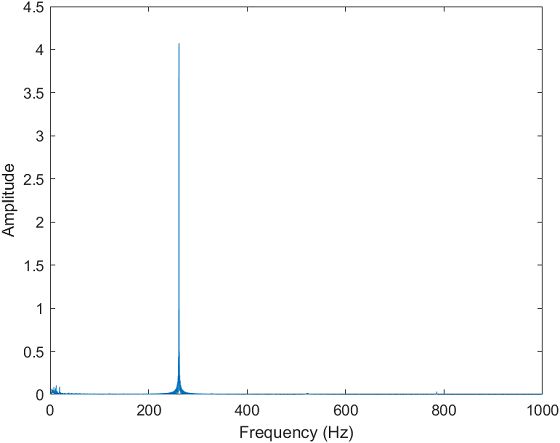Acquire and Analyze Sound Pressure Data from an IEPE Microphone
This example shows how to acquire and display sound pressure data from a PCB® IEPE array microphone, Model 130E20. The sensor is recording sound pressure generated by a tuning fork at Middle C (261.626 Hz) frequency.
Discover Devices That Support Microphones
To discover a device that supports microphone measurements, access the device in the table returned by the daqlist command. For this example, the microphone is connected on channel 0 of National Instruments® device NI 9234 on CompactDAQ Chassis NI cDAQ-9178 with ID cDAQ1Mod3.
d = daqlist("ni")
d =
12×4 table
DeviceID Description Model DeviceInfo
___________ __________________________________ _____________ ____________________
"cDAQ1Mod1" "National Instruments NI 9205" "NI 9205" [1×1 daq.DeviceInfo]
"cDAQ1Mod2" "National Instruments NI 9263" "NI 9263" [1×1 daq.DeviceInfo]
"cDAQ1Mod3" "National Instruments NI 9234" "NI 9234" [1×1 daq.DeviceInfo]
"cDAQ1Mod4" "National Instruments NI 9201" "NI 9201" [1×1 daq.DeviceInfo]
"cDAQ1Mod5" "National Instruments NI 9402" "NI 9402" [1×1 daq.DeviceInfo]
"cDAQ1Mod6" "National Instruments NI 9213" "NI 9213" [1×1 daq.DeviceInfo]
"cDAQ1Mod7" "National Instruments NI 9219" "NI 9219" [1×1 daq.DeviceInfo]
"cDAQ1Mod8" "National Instruments NI 9265" "NI 9265" [1×1 daq.DeviceInfo]
"Dev1" "National Instruments PCIe-6363" "PCIe-6363" [1×1 daq.DeviceInfo]
"Dev2" "National Instruments NI ELVIS II" "NI ELVIS II" [1×1 daq.DeviceInfo]
"Dev3" "National Instruments PCIe-6363" "PCIe-6363" [1×1 daq.DeviceInfo]
"Dev4" "National Instruments PCIe-6363" "PCIe-6363" [1×1 daq.DeviceInfo]
deviceInfo = d{3, "DeviceInfo"}
deviceInfo =
ni: National Instruments NI 9234 (Device ID: 'cDAQ1Mod3')
Analog input supports:
-5.0 to +5.0 Volts range
Rates from 1000.0 to 51200.0 scans/sec
4 channels ('ai0','ai1','ai2','ai3')
'Voltage','Accelerometer','Microphone','IEPE' measurement types
This module is in slot 3 of the 'cDAQ-9178' chassis with the name 'cDAQ1'.
Create a DataAcquisition and Add Microphone Channel
Create a DataAcquisition and add a channel with Microphone measurement type.
dq = daq("ni"); ch = addinput(dq, "cDAQ1Mod3", "ai0", "Microphone");
Set Sensor Properties
Set the microphone channel Sensitivity property to the value specified in the sensor's data sheet. For this sensor, the Sensitivity value is 0.037 Volts/Pascal. Examine the channel properties to see the changes in the device configuration.
ch.Sensitivity = 0.037; ch
ch =
Index Type Device Channel Measurement Type Range Name
_____ ____ ___________ _______ ___________________ ______________________ _______________
1 "ai" "cDAQ1Mod3" "ai0" "Microphone (Diff)" "-200 to +200 Pascals" "cDAQ1Mod3_ai0"
Configure and Start Acquisition
Set the acquisition scan rate to 51200 scans per second, then use read to acquire four seconds of data.
dq.Rate = 51200; tt = read(dq, seconds(4)); t = tt.Time; data = tt.cDAQ1Mod3_ai0;
Analyze Data
Use audioplayer to play back the acquired microphone signal
p = audioplayer(data, dq.Rate); play(p);
Examine the Data in the Time Domain
plot(t, data);
ylabel('Sound Pressure (pascals)');

Examine the Data in the Frequency Domain
Use fft and the following parameters to calculate the single-sided amplitude spectrum of the incoming data:
Calculate the length of signal (number of samples or entries in the table)
Calculate the nfft
Calculate amplitude and frequency
len = height(tt); nfft = 2^nextpow2(len); y = fft(data,nfft)/len; f = dq.Rate/2*linspace(0,1,nfft/2+1); A = 2*abs(y(1:nfft/2+1));
Plot the Single-Sided Amplitude Spectrum
plot(f,A); xlim([0 1000]); xlabel('Frequency (Hz)'); ylabel('Amplitude');

The plot shows a spike at 261.626 Hz. This matches the frequency of the tuning fork.